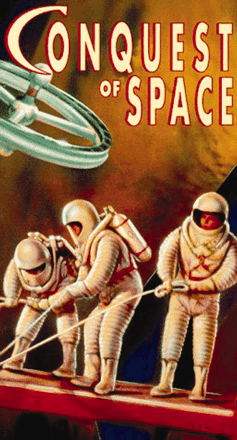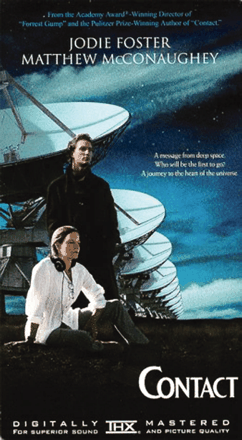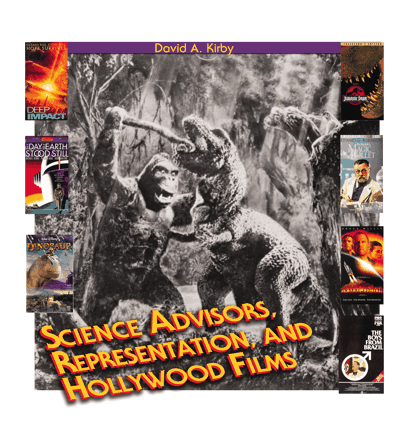Science Advisors, Representation, and Hollywood Films
- E-mail dk246{at}cornell.edu; fax 607-256-8101.
It will come as no surprise to the readers of Molecular Interventions that representations play an important role in scientific practice. Visual modes of presentation for theories and data are often the most effective, and even the nonscientist who wanders into a biomedical symposium will appreciate the heavy reliance on “visual aids.” The extensive use of visual devices dates back to the Scientific Revolution of the sixteenth century. Representations have a powerful communicative value because they allow those who cannot be present to “witness” natural phenomena (1) .
Steven Shapin and Simon Schaffer first put forth the notion of “indirect witnessing” in their seminal work Leviathan and the Air-Pump (2) . According to Shapin and Schaffer, Robert Boyle (1627–1691) mandated that the establishment of “matters of fact” should rest upon experiments that could be witnessed by all members of the scientific community. Of course, it was impossible for every member of the scientific community, even in Boyle’s time, to directly witness a scientist’s experiments. Therefore, according to Shapin and Schaffer, Boyle employed the “literary technology” of “virtual witnessing” to convince the community at large of “matters of fact.” Boyle’s lengthy experimental descriptions and detailed engravings were designed to provide remote scientific investigators with a means of “virtually witnessing” his experiments. Historians and sociologists of science have expanded on Shapin and Schaeffer’s definition of virtual witnessing to include any attempt to convince others of a scientific explanation without requiring them to directly witness an experiment or even the phenomenon itself.
Forums other than those provided by formal scientific texts and presentations can mediate virtual witnessing. Fictional films, because they can allow large sections of the public to witness phenomena that are experienced as “real,” can be considered as virtual witnessing technologies. In fact, the very purpose of fictional cinema is to blur the distinction between virtual witnessing and direct witnessing. The narrative framework in film is designed to highlight the representation’s “reality” and to make opaque its construction. This blurring is especially evident for natural phenomena that have never actually been “directly” witnessed (e.g., dinosaurs).

Admittedly, the construction of scientific phenomena for the cinema does not entirely proceed according to the scientific method, but is rather under the control of filmmakers. When science advisors are involved, however, they do indeed communicate their conceptions of the natural world. As I will show below, moreover, communication through film can play a role in the process of knowledge formation in cases where there are disputes among the scientific community. Film not only has the ability to act as a virtual witnessing technology, but also forces consensus on the public by presenting a single vision of nature in a perceptually realistic structure. Films are also successful communicative devices within the scientific community, whereby other scientists can respond to films by arguing for alternative scientific depictions. Similarly, science consultants use fictional films to promote their research fields in a public forum.
Science Advisors and Disputed Science
In most instances, the “facts” that filmmakers seek from science advisors can be answered according to a consensus within the scientific community. On the other hand, filmmakers may ask scientists to describe natural phenomena for which there is not an established explanation, so that the advisor’s version of “scientific fact” may not represent majority opinion. A fictional film, however, can offer only one from among alternative versions of the natural world. In the case of disputed science, the consulting scientist is more likely to get his or her vision of “fact” into the film and to exclude competing versions.
The 1978 film The Boys From Brazil , for example, portrayed scientific concepts not entirely accepted by the scientific community at that time. Based on the publicity surrounding his research on nuclear transplantation in rabbits (3) , developmental biologist Derek Bromhall of Oxford University was recruited as the film’s sole consultant. Bromhall’s responsibility was to construct an explanation of mammalian cloning that could be used in a scene in which the character Professor Bruckner explains cloning to the Nazi hunter Ezra Lieberman. The film presents the professor’s discussion of mammalian cloning in a very straightforward manner, as if anyone who wanted to achieve mammalian cloning would follow the protocol given in the movie. In the late 1970s, although there was considerable debate among the developmental community over prospective procedures for mammalian cloning, the film’s narrative describes a single protocol, which was fundamentally the version advocated in Bromhall’s own scientific research (4) . Although the scientific community had not yet settled on a protocol for cell-to-cell nuclear transplantion, discussions tended to center on cell–cell fusion, Bromhall’s technique, versus microinjection. In addition, biologists disagreed over the use of eggs as recipient cells, which Bromhall preferred, as opposed to the use of fertilized zygotic cells. Even the animal that would best serve as a vehicle for mammalian cloning, rabbit or mouse, was under debate. The film, of course, does not imply uncertainty about any of these aspects, but instead presents Bromhall’s conception of mammalian cloning as the only feasible model.
Fictional Representation and Perceptual Reality
Despite their fictional nature, on-screen images in Hollyowood films carry the weight of virtual witnessing technology because they appear to be “real.” Film theorists have recently grappled with the idea of “realism” in regards to special effects and are now revising old theoretical models to accommodate the rise of computer-aided digital imaging (5) . Film theorists argue that rather than being “unrealistic,” films that heavily rely on special effects actually embody realist filmmaking in that they must make “unreal” images appear “real.” As stated by Noel Carroll, contemporary film theorists now “agree that in its standard uses, film imparts a realistic effect to its viewers” [italics in original (6)]. “Realism,” in fact, is the reason filmmakers consult scientists in the first place. A science advisor’s job is to make sure that the scientific images are not “fiction” but that they conform to “natural reality.” By claiming scientific legitimacy for their films through the use of science advisors, filmmakers add to the “naturalizing” effect of cinema. They encourage audiences to think that their scientific representations are not only plausible but that they reflect the realities of the natural world.
Stephen Prince has effectively argued that the key to understanding the realistic effect is not to consider filmic images as conforming to referential reality, but rather that they are perceptually realistic (7) . Filmmakers design images, even unreal images, to correspond to cues with which viewers normally interact. Familiarity with these cues compels the audience to perceive unreal images as realistic. Prince uses Jurassic Park (1993) as an example of how filmmakers create perceptually realistic images using digital technology: Because of the accuracy of digital technology, we see unreal animals (i.e., dinosaurs) that match the movement, appearance, and sounds of animals with which we have interacted; we thus perceive these images as realistic even though they are not actually real. This perception enhances the film’s persuasiveness and mediates its functionality as a virtual witnessing technology.

The work of Martin Barker and Kate Brooks on audience reception of the film Judge Dredd (1995) supports the notion of perceptual reality (8) . They interviewed filmgoers about their perceptions of the future world depicted in the film and found that audiences make judgments about what is “plausible” within the film’s diegesis, not necessarily what is “real.” That plausibility leads to the perception of reality is important because, as paleontologist Kevin Padian has shown, popular images’ role in the acceptance of scientific concepts depends not on their correspondence to “reality” but rather on their plausibility (9) . According to Padian, pictorial representation is a “powerful determinant of perception” that “need only be plausible, not accurate, to become fixed in the mind’s eye.” In his study of the taxonomic construction of pterosaurs, Padian found that scientific reconstructions can depend on popular conceptions even more than on scientific evidence, declaring, “The popular reconstruction of pterosaurs assumed an important role in establishing the acceptance of the bat-winged image, in spite of the lack of evidence then or now for it.” In the end, Padian concludes that “a picture is not only worth a thousand words; however inaccurate, it may be worth a wealth of documented evidence to the contrary.”
Fictional Films, Virtual Witnessing, and the Non-Specialist Community
Communication researcher Leah Lievrouw states that science popularization serves several purposes, one of which is a “process by which a scientific idea gains currency in the everyday discourse of the general public” (10) . As virtual witnessing technologists, science advisors can utilize fictional films to “confirm” the existence of phenomena and, regardless of their intent, disseminate their concepts among the general public. For example, special effects technicians Willis O’Brien and Marcel Delgado consulted with several paleontologists in order to create the dinosaurs in King Kong (1933). In one case, they consulted Barnum Brown about a contentious issue in the depiction of Tyrannosaurus rex . Specifically, in the 1920s and 1930s, the number of digits on T. rex ’s forelimb was open to debate. Brown, who was then famous for his reconstruction of T. rex for the American Museum of Natural History in New York, vociferously maintained that T. rex had three digits on its forelimb. More than likely, Brown was not thinking about persuading the lay public to his conception of T. rex when he recommended a three-digit T. rex to the filmmakers; however, his insistence on this depiction for T. rex in King Kong guaranteed that millions of people would “witness” his vision of T. rex morphology and thus, he propagated his version of natural “reality” (11) . As discussed above, the proximity of advisors to filmmakers significantly increases their opportunities to disseminate their conceptions of the natural world to the non-specialist community.
In addition to its ability to help advisors promote their conceptions of nature to lay audiences, filmic presentations to the public can influence science in other ways. Sociologists and historians have often demonstrated that popularization is akin to promotion, especially with regard to obtaining funding or other support for scientific research. As sociologist Stephen Hilgartner notes, “A mountain of evidence shows that experts often simplify science with an eye toward persuading their audience to support their goals [to] build support for research programs” (12) .
It is fictional film’s ability to introduce “scientific possibilities” into the audience’s mind that leads scientists to believe that “realistic” depictions can lead to higher funding levels. Joel Black refers to this ability as the “War Games effect,” after the 1983 film, and claims that “by presenting apocalyptic narratives in the fictional form of movies or thrill rides, special-effects technicians are…playing (or banking) on the notion that… they are preventing them [i.e., doomsday scenarios] from happening” [italics in original, (13) ]. Virologist Peter Jahrling of the U.S. Army Medical Research Institute of Infectious Diseases buys into the War Games effect, making the connection between realism in fictional film, public awareness, and increased research funding in a Health magazine article on the film Outbreak (1995):
‘If the film has a ring of truth to it, people will walk out thinking, Jesus, that story may have been fiction, but it could
happen, couldn’t it? But if it’s clearly just science fiction, they’ll write it off like the latest Sylvester Stallone movie.’
Which would be too bad, says Jahrling, because only a fired up public will favor spending research dollars on vaccines and
other precautions against an obscure killer virus before it goes global, not after [italics in original, (14) ].
The War Games effect is a major reason why scientists worry about the image of science in fictional pieces. They perceive that popular cultural portrayal is connected to popular opinion and thus funding (15) .
Indeed, many advisors perceive fictional film as a way to promote their science in the hope of convincing the public that their research is worthy of increased research funding. Often, advisors will proclaim that the film on which they are working highlights an issue that needs more “attention” from the American public. For example, Near-Earth-Objects (NEOs) permeated the scientific and cultural climate in 1997, the year Deep Impact and Armageddon (1998), two films that deal with catastrophic asteroid/comet impacts upon the earth, went into production. These films provided an opportunity for science advisors, all of whom had a stake in NEO research and funding, to present the hypothetical dangers of NEOs to the public. For example, Joshua Colwell, whose research involves “small objects” in the solar system (e.g., comets), hoped that his consulting work on Deep Impact would help inform the public about the dangers of comet impacts (16) :
The more realistically things are portrayed, the better it is for everyone—producers and public alike. The basic premise of
Deep Impact is scientifically sound in that life on Earth faces a threat due to comet and asteroid impacts. That threat might be mitigated
through observation and destruction or deflection of the object with nuclear bombs. The fact that the movie made an effort
to portray all this realistically helps convey this message to the public and raise awareness of a real issue.
Many news commentators, in fact, opined that the publicity surrounding these two films, and their influence of public opinion, played a major role in the development of a NEO agency in the U.S. An editorial in the Denver Rocky Mountain News , for example, claimed that the U.S. Near-Earth Object Program Office, founded in June of 1998, would not have come into existence without the help of these two films and other popular cultural sources (17) :
Sensationalize it, and the government will follow. Thanks to movies like Armageddon and Deep Impact and TV shows like “Asteroid” and countless lurid magazine covers about asteroids and comets destroying Earth, or at least seriously damaging midtown Manhattan, NASA has set up a special office to track threatening stuff in space.
Members of Parliament, such as Lembit Opik, and Britain’s Science Minister, Lord Sainsbury of Turville, acknowledge the direct role the two films played in their decisions to lobby for the British National Asteroid and Comet Information Centre (NACIC), and ultimately in their ability to establish the governmental task force. Opik, who led the charge for the task force, directly attributes its passage to the public support garnered by the two films (18) :
Two or three years ago there was a high giggle factor about NEOs but in the last 18 months the scientific community and the
general public have changed their view measurably. The popular media has woken up to the threat because of Deep Impact and Armageddon .
Lord Sainsbury has further acknowledged that that public concern over the chances of annihilation were expressly heightened by the two Hollywood movies (19) . This example shows that not only members of the scientific community, but also governmental policy makers themselves, consider fictional films to be effective promotional tools. Science advisors who are involved in the construction of films can thus significantly shape the public face of their research areas and help make the case for more research support.
Fictional Films and the Specialist Community
Several studies over the last ten years have found that newspaper and magazine readership is not limited to the “lay” public; popularized accounts of science are also digested by scientists. Massimiano Bucchi has persuasively argued that the “active influences of the popular discourse of science cannot be reduced to feedback mechanisms of public support and legitimization” (20) . Bucchi has documented that accounts in non-technical media “can foster the inclusion or exclusion of actors or theories from the specialist’s discourse, and it [i.e., popular accounts] can make room for new interpretations or confer a different status on existing models by linking them to other public issues and themes.” Bucchi and others show that science communication outside of technical literature is not limited to “disseminating” scientific knowledge to non-specialists, but rather can function additionally as communicative devices within the scientific community.

A reading of science advisors and fictional films as intra-specialty communication, however, requires evidence that the advisors’ representations are successfully communicated to other scientists. Evidence that scientists have received filmed models is documented by their public responses to the models and images in films. Most often these responses come in the form of The Real Science of … articles in newspapers and magazines, in which a scientist critiques the “scientific accuracy” of a fictional film, or in “cinematic science reviews” for research journals such as Nature and Science . When scientists critique scientific representations made with the assistance of a science advisor, they often criticize the advisor’s conceptions of scientific “facts” (21) . I will use the Jurassic Park film series to demonstrate how fictional films can subserve intra-specialty communication.
Jurassic Park and its two sequels, The Lost World and Jurassic Park III , feature aspects of dinosaur evolution and ecology that are not entirely accepted by the scientific community. Science advisor Jack Horner is a well-known proponent, and progenitor, of many of the disputed ideas in the film. In the case of Jurassic Park III , Horner says that his involvement started at an earlier point than for the other films and that he therefore held a larger sphere of influence (22) . Specifically, he convinced filmmakers to include points about dinosaur “accuracy,” such as the feeding habits of T. rex , that he had been unable to champion in the two earlier films; Horner had been particularly upset about the depiction of T. rex as a predator (23) . In Jurassic Park III , Horner successfully persuaded the filmmakers to incorporate his own hypothesis that T. rex was a scavenger rather than a killer (24). Although the inclusion of a scavenging T. rex increased the “accuracy” of the film in Horner’s opinion, the majority of the paleontological community does not, in fact, accept his view. Significantly, whereas Horner was able to widely disseminate his beliefs through their portrayal in a fictional film, paleontologists such as Sue Hendrickson, who disagrees with the T. rex– as-scavenger hypothesis, were left to respond about T. rex ’s depiction in Jurassic Park III through the news media, scientific journals, and other relatively limited outlets (25) .
Other hypotheses that Horner brought into the Jurassic Park series include the warm-blooded nature (i.e., homeothermy) of dinosaurs, the theropod–bird evolutionary connection, the communal nature of dinosaurs, a sophisticated means of communication in Velociraptor , and the nurture of young in T. rex . None of these concepts have a consensus in the scientific community, and many of them are the subjects of heated debates.
Scientists who disagree with Horner’s depictions in the Jurassic Park films have found other outlets to express their notions of “truth.” The Interplanetary Dinosaur Gazette hosts a list of competing paleontologists’ alternative beliefs about dinosaurs, labeling Spielberg and Horner’s fictionalized science as “science bloopers” (26) . The late Harvard University paleontologist Stephen Jay Gould also disagreed with many of the dinosaur depictions in Jurassic Park , criticizing the film’s “currently fashionable” depictions in The New York Review of Books (27) . Gould did not relegate the disputed interpretations to the category of “science bloopers” on the part of filmmakers, but instead referred to the film’s depictions as “professional speculation.” Gould wrote, “As a practicing paleontologist, I confess to wry amusement at the roman-à-cleffery in the reconstructions. I could recognize nearly every provocative or outré idea of my colleagues” (28) . The popular Hollywood film thus engaged Gould, as a legitimate “practicing paleontologist,” to debate controversial scientific ideas and to label the concepts of another paleontologist (i.e., Horner) as outré , or bizarre.
Conclusion
In 2002, a Time magazine article discussed the theory that dust from an asteroid impact caused the extinction of the dinosaurs and in particular described Kevin Pope’s challenge to the theory. Time ’s article contained a still from Dinosaur (2000) with the caption, “Even Disney has accepted the asteroid theory” (29) . Time thus relied on a Disney film as a cultural barometer to measure the acceptance of scientific thought and to stress the battle that Pope faces amid mass representation supported by science advisors in movies such as Deep Impact , Armageddon, and Dinosaur . Pope, who does not (yet) have access to a fictional film for the mass dissemination of his own ideas, resorted to sending out a press release to promote his findings (30) .
Pope’s experience highlights the role that fictional films can play in the formation of consensus and closure in scientific disputes. In scientific practice a scientist’s knowledge claim is validated as “fact” only when consensus is reached, a process that depends heavily on rhetoric and representational techniques of persuasion. From an anthropological perspective, modern scientists utilize multiple means, including representations in fictional films, to convince people of their research claims. Film, in fact, can have a very powerful epistemological impact because of its virtual witnessing capacity. Film has the ability to create an image of the natural world on the screen and can thus shape the thoughts of a huge audience in regard to scientific issues. Film images can powerfully communicate such messages as “Here is how to find a cure for a viral epidemic;” “This is how dinosaurs communicate;” “An effective cloning protocol can be performed in this way.” When scientists design representations for films, they have perhaps unparalleled power to spread their own particular conceptions of viruses, dinosaurs, and the natural universe itself. Film, moreover, does not imply uncertainty about its imagery. Fictional films, in essence, force a consensus through the “reality effect,” even though the resulting consensus may be based on an illusion. Hollywood films produce a “naturalizing” effect on their subject matter.
The number of scientists who consult on fictional media projects is steeply increasing as consulting becomes standard practice in the entertainment industry (31) . Still, it is a small percentage of scientists who serve as advisors on fictional films. Because of the great persuasive power that film can thus impart to relatively few scientists, it is important to understand the role of fictional films in science communication and scientific practice. The battleground over scientific ideas is not limited to scientific meetings and publications, or even to traditional popularizing realms such as documentaries and news articles. Any time a scientist discusses, or portrays, scientific information, he or she is engaged in an act of persuasion.
- © American Society for Pharmacology and Experimental Theraputics 2003




